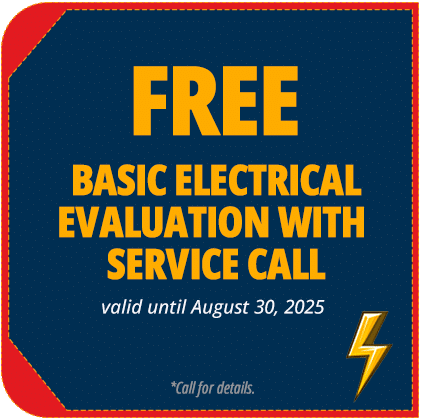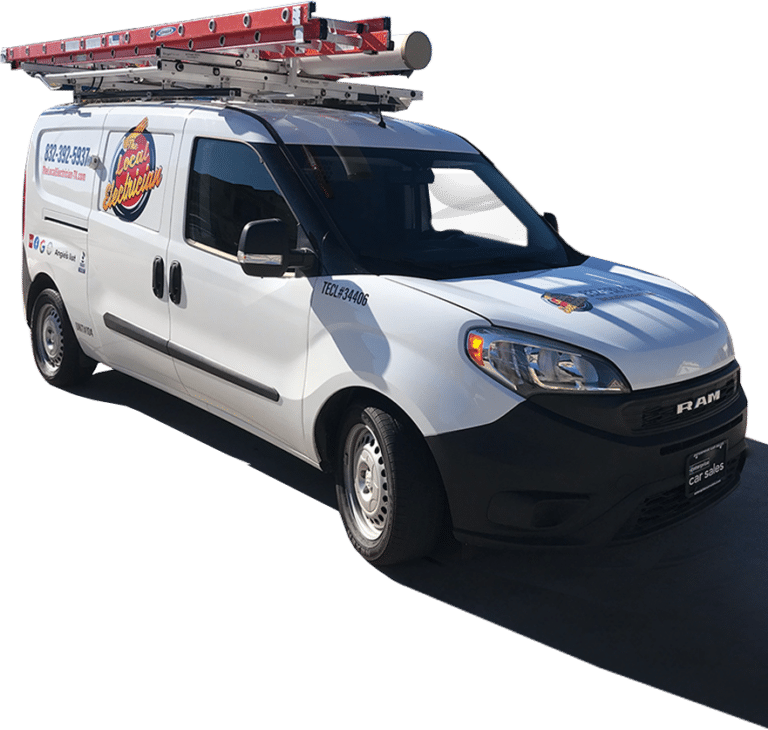Experiencing an outlet not working can be frustrating and even concerning. Whether it is a single dead outlet or a pattern of power loss in your home, electrical issues should not be ignored. Many homeowners in Katy, TX, and Friendswood, TX face similar problems, often unsure of the cause.
Understanding why an outlet stops functioning can help you know when to call a professional. Let’s explore the most common reasons behind a non-working outlet and why hiring a licensed electrician is always the safest choice.

Tripped Circuit Breaker: A Common Issue
A tripped circuit breaker is one of the most common reasons for an outlet not working. Circuit breakers prevent electrical overloads by shutting off power when too much electricity flows through a circuit.
When a breaker trips, power to connected outlets is disrupted. Checking the electrical panel can help determine if a breaker is in the “OFF” position. If resetting it restores power, the issue may have been a temporary overload. However, frequent breaker trips signal deeper electrical problems that need professional attention.
Circuit overloads happen when too many high-powered devices operate on the same circuit. Space heaters, hairdryers, and kitchen appliances can quickly exceed the circuit’s capacity. Older homes in Friendswood and Katy may have outdated wiring, making them more susceptible to overloads.
Ignoring a frequently tripping breaker can lead to wiring damage, overheating, and fire hazards. A licensed electrician can assess your home’s electrical system, identify weak points, and recommend solutions. Upgrading the electrical panel or redistributing power loads can prevent future disruptions.
If your outlet not working and the breaker keeps tripping, consult an expert. Ignoring the issue increases risks, potentially leading to dangerous electrical failures in your home.
GFCI Outlet Tripped: Resetting the Safety Feature
A Ground Fault Circuit Interrupter (GFCI) outlet is designed to prevent electrical shocks, especially in moisture-prone areas like bathrooms, kitchens, and outdoor spaces. These outlets shut off power when they detect an electrical imbalance, reducing the risk of electrocution.
If a GFCI outlet trips, other connected outlets on the same circuit may also lose power. Pressing the RESET button on the GFCI outlet may restore function. However, if the outlet trips repeatedly, there could be an underlying issue, such as faulty wiring or moisture exposure.
GFCI outlets are essential in homes located in humid regions like Friendswood and Katy, TX. Moisture increases the risk of electrical shorts, making GFCI outlets critical for safety. If your outlet not working in these areas, check nearby GFCI outlets before assuming a bigger issue.
When a GFCI outlet fails to reset, professional intervention is necessary. Faulty GFCI outlets or wiring issues require proper diagnosis and repair to maintain household safety. Replacing or upgrading old GFCI outlets ensures continued protection against electrical hazards.
If your outlet not working and resetting the GFCI does not help, an electrician can troubleshoot and fix the problem safely.
Loose or Damaged Wiring: Hidden Electrical Dangers
Loose or damaged wiring is another common reason for an outlet not working. Electrical outlets depend on secure wiring connections to provide power. When connections loosen over time, outlets may stop functioning or cause intermittent power loss.
Signs of faulty wiring include sparks, flickering power, discolored outlets, and unusual buzzing sounds. Outdated or deteriorated wiring is especially common in older homes in Friendswood and Katy, TX. If ignored, loose wiring can lead to overheating and increase the risk of electrical fires.
Rodents, construction work, or improper installations can also damage wiring. If an outlet stops working and you notice burning smells, turn off the power immediately and contact an electrician. Ignoring these warning signs can lead to costly repairs or hazardous electrical failures.
Attempting to repair damaged wiring without proper training is extremely dangerous. DIY electrical fixes can result in electrocution, short circuits, or home fires. Only licensed electricians should handle wiring repairs to ensure safety and compliance with electrical codes.
If your outlet not working and you suspect loose wiring, do not take risks. A professional can inspect, repair, or replace the faulty wiring to restore safe power to your home.
Overloaded Circuit: Too Many Devices Plugged In
An overloaded circuit is another reason for an outlet not working. Circuits have a limited electrical capacity, and exceeding that limit can cause the breaker to trip or the outlet to fail.
Plugging multiple high-wattage devices into a single outlet can overwhelm the circuit. Common culprits include microwaves, refrigerators, space heaters, and hairdryers. If your outlet stops working after plugging in a powerful device, the circuit is likely overloaded.
Older homes in Friendswood and Katy, TX may not have circuits designed for modern electrical demands. If your home lacks sufficient outlets, you may rely on power strips or extension cords, increasing the risk of overloading.
Professional electricians can assess your home’s electrical system and recommend circuit upgrades or additional outlets to prevent overload issues. Installing dedicated circuits for heavy-use appliances ensures a safer and more reliable power supply.
If your outlet not working due to an overloaded circuit, upgrading your electrical system can prevent recurring power failures. A professional can provide solutions tailored to your home’s power needs.
Faulty Outlet: Signs It Needs Replacement
A faulty outlet is another common reason for an outlet not working. Over time, outlets wear out, leading to poor connections and electrical failures.
Common signs of a failing outlet include loose plugs, burn marks, buzzing noises, and inconsistent power flow. If a device works in one outlet but not another, the non-working outlet is likely defective. Worn-out outlets can pose fire and shock hazards, especially in older homes.
In Friendswood, TX and Katy, TX, many homes have outdated electrical systems with aging outlets that may not meet modern safety standards. Two-prong outlets, for example, lack proper grounding, increasing the risk of electrical shocks. Upgrading to three-prong or GFCI outlets can improve electrical safety.
Attempting to replace an outlet without professional help is dangerous. Incorrect wiring can lead to electrical shorts, overheating, or fire hazards. A licensed electrician can safely replace and upgrade your outlets, ensuring compliance with Texas electrical codes.
If your outlet not working and shows visible damage, it is time for a professional inspection and replacement. A new, properly installed outlet will improve safety and ensure consistent power in your home.
Half-Hot Outlets: Understanding Switched Outlets
Some homeowners discover an outlet not working because it is part of a half-hot outlet system. These outlets are wired to a wall switch, allowing control of a connected lamp or appliance.
If only one half of the outlet provides power, check nearby wall switches. If flipping the switch restores power, the outlet is functioning as designed. However, if the switch no longer works or the outlet does not respond, wiring issues may be the cause.
Half-hot outlets are common in older homes, especially in Friendswood and Katy, TX, where traditional lighting setups use switched outlets instead of ceiling fixtures. While convenient, they can confuse homeowners who are unaware of their function.
A malfunctioning half-hot outlet may indicate loose wiring or a faulty switch. If power loss occurs without reason, an electrician can inspect the outlet and ensure safe operation. Some homeowners prefer converting half-hot outlets into fully powered outlets for modern use.
If your outlet not working, and you suspect it is part of a half-hot system, a professional can rewire it for full-time power, enhancing convenience and reliability.
Burned-Out Outlet: Signs of Electrical Damage
A burned-out outlet is a serious electrical hazard that often causes an outlet not working. Overheating, faulty wiring, and excessive power loads can damage an outlet’s internal components.
Signs of a burned-out outlet include black scorch marks, melted plastic, a burning smell, or heat when touched. If plugging in a device causes sparks or flickering, the outlet may be compromised. Burned-out outlets increase the risk of electrical fires and require immediate replacement.
Older homes in Friendswood and Katy, TX may have outdated wiring that cannot handle modern electrical demands. If an outlet burns out frequently, the underlying electrical system may be struggling with excess load. A professional electrician can evaluate whether wiring upgrades or additional circuits are necessary.
Attempting to use a damaged outlet can lead to further electrical failures. Do not continue plugging in devices if you notice burn marks or heat. Instead, contact an electrician to safely replace the outlet and inspect the wiring.
If your outlet not working and shows signs of burning, it is essential to address the issue immediately. Professional intervention ensures safety and prevents future electrical hazards.
Defective Light Switch Controlling the Outlet
In some homes, an outlet not working may be linked to a faulty light switch. Many outlets are connected to wall switches, allowing homeowners to control lamps or appliances with a flip of a switch.
If the controlling switch is defective, the outlet may stop working. Testing the switch with another outlet or fixture can help determine if the issue lies with the outlet or the switch itself. If other outlets work fine, the switch may need repair or replacement.
Worn-out or incorrectly wired switches can cause intermittent power failures in controlled outlets. Homeowners in Friendswood and Katy, TX may experience these issues in older homes where electrical components degrade over time. A licensed electrician can replace faulty switches and restore proper function.
In some cases, homeowners prefer converting switched outlets into always-on outlets for convenience. An electrician can rewire the outlet, allowing it to function independently from the switch.
If your outlet not working due to a defective switch, professional repairs will ensure safe and consistent power. Avoid DIY electrical work to prevent potential wiring mistakes or safety risks.
External Power Issues: Grid or Utility Problems
Sometimes, an outlet not working is not caused by an issue inside the home but by external power problems. Texas homes, particularly in Friendswood and Katy, can experience power surges, brownouts, or grid failures that affect outlet functionality.
A neighborhood-wide power issue may cause multiple outlets to stop working at the same time. Before assuming an internal electrical failure, check whether nearby homes are also experiencing power loss. If the problem extends beyond your home, contact your utility provider to report the outage.
Power surges from electrical storms or grid fluctuations can damage outlets and appliances. Installing surge protectors can help safeguard against sudden voltage spikes. If outlets frequently fail after storms or outages, an electrician can inspect and reinforce your home’s electrical system.
If your outlet not working, and utility-related issues are suspected, verify external power conditions before scheduling repairs. A professional can assess whether internal damage has occurred due to external electrical fluctuations.
Preventative Electrical Maintenance for Safe Outlets
To avoid unexpected outlet not working issues, homeowners should adopt regular electrical maintenance practices. Routine inspections can catch wiring problems, overloaded circuits, and aging outlets before they lead to failures.
A licensed electrician should inspect your home’s electrical system every few years, ensuring that outlets function correctly and meet current safety codes. Homes in Friendswood and Katy, TX, with older wiring, may require upgrades to handle increased electrical demands.
Best practices for outlet safety include:
- Avoid overloading outlets with multiple high-wattage devices.
- Use surge protectors to prevent damage from power surges.
- Replace worn-out or damaged outlets before they fail.
- Ensure all GFCI outlets work properly, especially in moisture-prone areas.
- Never ignore burn marks, buzzing noises, or loose plugs—these signs indicate potential hazards.
If your outlet not working, addressing minor issues early can prevent costly electrical failures. Professional inspections help maintain a safe and efficient home electrical system.

Trust Professionals for Safe Electrical Repairs
When an outlet not working, it is more than just an inconvenience—it can signal a serious electrical problem. Whether the issue stems from a tripped breaker, faulty wiring, a tripped GFCI, or circuit overload, proper diagnosis is crucial.
Attempting DIY electrical repairs can increase safety risks and violate Texas electrical codes. Professional electricians ensure that outlets function safely, reducing the risk of shocks, fires, or power failures. Ignoring outlet issues can lead to costly damage or hazardous conditions in your home.
Residents of Katy and Friendswood, TX should prioritize regular electrical inspections to prevent sudden failures. Licensed electricians can identify and fix underlying problems before they escalate, ensuring a safe and efficient home.
If your outlet not working, do not take chances. Contact The Local Electrician today for a professional inspection and safe, reliable repairs that keep your home powered and protected.
FAQs About Outlet Not Working
-
Why is my outlet not working, but the breaker is not tripped?
A non-working outlet without a tripped breaker could be caused by a tripped GFCI outlet, loose wiring, or a faulty outlet. Check nearby GFCI outlets and press the RESET button. If that does not work, consult an electrician to inspect for wiring issues.
-
How do I know if my outlet needs to be replaced?
Signs that an outlet needs replacement include burn marks, loose plugs, buzzing sounds, intermittent power, or discoloration. If plugging in devices causes sparks or flickering, the outlet is likely faulty and should be replaced by a licensed electrician.
-
Can I fix a dead outlet myself?
DIY electrical work is dangerous and can lead to shocks, fires, or incorrect wiring. While you can check your breaker or reset a GFCI, anything beyond that should be handled by a professional electrician to ensure safety and compliance with electrical codes.
-
Why does my outlet spark when I plug something in?
A small spark can be normal, but large, frequent sparks, burning smells, or black marks indicate a serious problem. This could be due to loose wiring, worn-out outlets, or overloaded circuits. A professional should inspect and repair the issue immediately.
-
What causes an outlet to overheat?
Overheating outlets are typically caused by loose connections, overloaded circuits, or faulty wiring. If an outlet is warm to the touch or shows signs of burning, stop using it and call an electrician. Overheating can lead to electrical fires.
-
How do I reset a GFCI outlet?
Press the RESET button on the GFCI outlet to restore power. If it does not reset or trips repeatedly, there may be moisture exposure, a ground fault, or a wiring issue. Contact an electrician if the problem persists.
-
Why do some outlets stop working after a power surge?
Power surges can damage electrical components inside outlets, causing them to fail. Homes in Katy and Friendswood, TX, are prone to thunderstorms and electrical fluctuations. Installing surge protectors helps prevent outlet damage during surges.
-
Should I be concerned about flickering lights and a dead outlet?
Yes. Flickering lights and a non-working outlet could indicate a loose connection, faulty wiring, or an overloaded circuit. These symptoms should be evaluated by a professional to prevent potential electrical fires.
-
How often should electrical outlets be inspected?
It is recommended to have electrical outlets inspected every few years or if you experience power loss, buzzing sounds, or signs of overheating. Homes older than 20 years may require outlet upgrades or rewiring to meet modern safety standards.
-
Who should I call if my outlet stops working?
If your outlet not working, call a licensed electrician. Professionals can safely diagnose and fix the issue, ensuring your home’s electrical system functions properly and meets safety regulations.






























